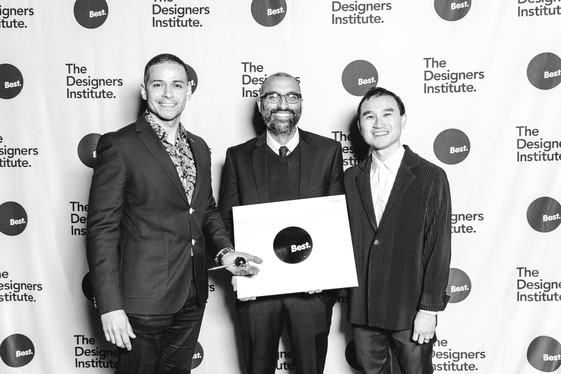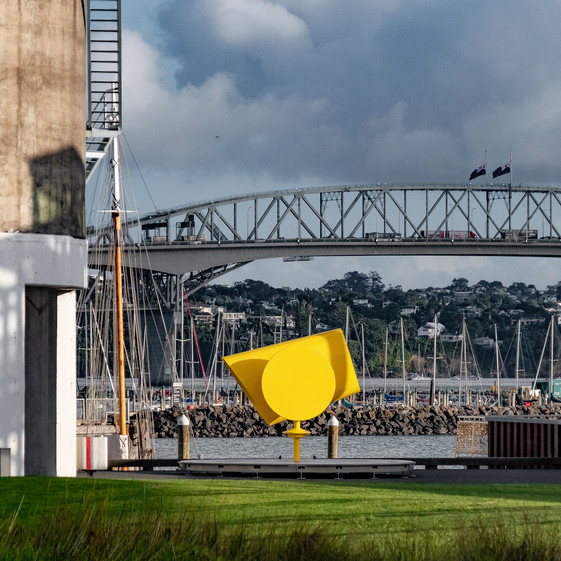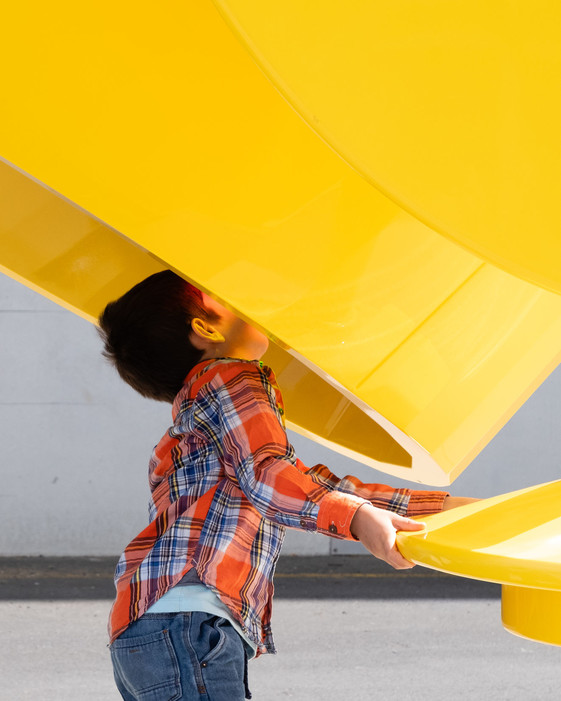Each week the Designers Institute releases a case study on a Best Design Awards 2019 Purple Pin winner
– a project description in the words of the designers along with a short interview with writer Mike Barrett.
Purple Pin Case Study — Spatial
Shahriar Asdollah-Zadeh, Patrick Loo, Sarosh Mulla
Rainbow Machine
Spatial: Rainbow Machine
Studio: Shahriar Asdollah-Zadeh, Patrick Loo, Sarosh Mulla

Rainbow Machine
Project Description
As Auckland expands and higher-density dwellings become prevalent, how can the city provide interesting, exciting and stimulating amenities for families? Rainbow Machine, an interactive play experience that children can enjoy with their families, is one answer to that question. Commissioned by Auckland Council, it’s an immersive experience of natural-light manipulation through interactive play. Put more simply – who doesn’t want to make some rainbows?
Rainbow Machine is a result of design, art, science, engineering and innovation coming together to generate an ephemeral moment of saturated colour. Light is one of the fundamental elements we need to exist, yet often we don’t comprehend, much less give any thought to its true value within our daily lives.
In form, Rainbow Machine is reminiscent of the mechanical devices often found in children's playgrounds. Elements (such as the geared wheels) are positioned and shaped to encourage curiosity and intuitive interaction. Hung above the ground on a rotatable post, the cone is scaled for children but also accessible by caregivers. The custom-made prism and optical module were built using specialised telescope manufacturing processes, and colour is a critical component of the exterior finish. The welcoming yellow is a communication device that attracts young and old, references the sun and provides a happy and playful tone.
Rainbow Machine is not fixed – it can move from site to site, be installed at parks, playground, events and festivals. It’s a design that bridges the gap between contemporary play-space design and interactive experience, and provides a simple way for people of all ages and abilities to enjoy one of nature’s most intriguing phenomena.

Shahriar Asdollah-Zadeh, Sarosh Mulla, Patrick Loo
Q+A
Mike Barrett talks to Shahriar Asdollah-Zadeh (Artist & Designer), Patrick Loo (OPL) & Sarosh Mulla (PAC Studio).
Ok, so whose idea was this, where did the idea come from?
Shahriar: The Auckland Council public art team and Waitematā Local Board were interested in developing a project for children within the city. We took this as an opportunity to really explore what urban intervention could mean in the context of play. We wanted to design an interactive art installation for children and adults and let them interact and experience it together through discovery, activation and play. We thought it would be great to create something that people wouldn’t expect to find, but by inspiring curiosity, realise it was something they could interact with.
The idea was drawn out through art research, drawings, model making and playground visits. We were fixated on creating an experience using rainbows – it was just a matter of time before we resolved the form and function. We worked with a lot of remarkable people on this project. One of the first physicists we met said, “you want to make a what?” and “yes, it's possible…in theory”, with a smile on their face. So that spurred us on.
We were also committed to making something dynamic – rainbows that can be controlled and created by users. We found some inspiration in the light installations of Olafur Eliasson’s studio, as well as James Turrell. Understanding the conceptual ideas underpinning their works reinforced that were heading in the right direction and helped us refine our concept.
As I understand it, the project had quite a long gestation period. What were the main challenges in getting it off the ground?
Shahriar: The rainbow itself was a challenge. How could we make visible the dispersed spectrum of a giant rainbow in broad daylight, without any water, without dim lighting, to an adjusting iris? The cone’s design, shape, height, optical-prism module, custom prisms and rotational wheel speed all play a part in achieving this effect. The prisms are such beautiful objects – a lot of focus was given to how they would disperse light, the saturation of the spectrum and how the inner cone would capture and provide a subtle backdrop for the colour spectrum, which would cast across it and onto your skin.
Another challenge was finding people as passionate as us to make it happen. Rainbow Machine is a combination of art, design, science, engineering and user experience. It wasn’t just about approaching collaborators with a, “hey can you make this happen for us”, it was finding people who remembered when they were young; like remembering third form science class, building the prism light test and seeing a rainbow shoot out through the paper split for the first time. Marveling at how white light is made from invisible colour frequencies and understanding, at that young age, that “wow, science is cool”.

Did you test it before you pushed it out into the world?
Shahriar: Yes, and what was important about this was testing with children to understand how they react and play with a large object, because it’s entirely different to an adult’s approach. Adults assume kids will do one thing but instead, they will often do something unexpected. Kids are smart, and through play and talking with each other they can figure things out quickly. We see this happen with Rainbow Machine all the time. As soon as one kid learns how to use it, they’ll pass on that knowledge and excitement to the next kid. Kids love big wheels and turning objects that are shaped to be grabbed and fit within the palm of their hands in playgrounds. It’s a multi-tonne object but a four-year-old can easily move it. It’s also inter-generational – an older person with arthritis in their hands can also gently move it.
You had an artist and two architects as the core team on this project. What was the division of labour like?
Shahriar: I was trained as a conceptual and installation artist at Elam and have taken those skills into my design practice. Working alongside Patrick and Sarosh, with their architectural design practices, and our combined multidisciplinary backgrounds allowed a collaborative process that pushed our ideas so much further. The most exciting ideas come through collaboration and working at the edges of where creative disciplines cross over; it is at this intersection that art and design can have an impact. Add to that the engineers, fabricators and scientists who were equally invested in the project and you have an amazing formula. It’s really special when you can align a creative team and stakeholders to a shared vision. When it happens, you know you’ve done something right. Ōtāhuhu Engineering, Callaghan Innovation, Kiwi Star, Holmes Consulting and Auckland Council – every contributor played a significant specialised role and understood the creative opportunity in front of them.

Sarosh, one of your previous projects, Penumbral Reflections, was also concerned with light refraction and reflection. Did this project extend the knowledge you developed on that project?
Sarosh: My work has always been concerned with optics and spatial and movement through space. Penumbral Reflections was actually designed alongside Rainbow Machine and the two projects bounced off each other in my mind, heading in different directions, but linked by an interest in how light creates space. Rainbow Machine is, in its essence, about the joy that can be created by light; it’s about a simplicity of experience that is shared with others and doesn’t need to be explained beyond the emotion it creates. Penumbral Reflections is the opposite, it's about visual complexity and darkness rather than light in many ways. It also requires heaps of explanation! The projects crossover though when you think about the subjectivity of our sight. No two people ever see Penumbral Reflections or Rainbow Machine’s spectrum in exactly the same way. That creates a basis for discussion and understanding of our different views and experiences that expands beyond either artwork.
Can one of you give me a 10-second break down on how it works? What are the key components?
Patrick: It’s all about discovery and interactive play. The public can create rainbow patterns through the manipulation of an adjustable prismatic viewing cone. They can pivot the cone towards the sun, using two geared wheels (large and small). When the right angle is struck, natural light is passed through a series of prisms and mirrors at the top of the cone, which refracts the light to produce a rainbow. The inner cone provides a darkened surface for the colour spectrum while creating a space where one can focus on the rainbow effect without distraction. By setting the cone at differing angles, a variety of unique projections will be created. It’s an immersive environment that promotes embodied learning for children by prompting questions and explanations between child and caregiver. On multiple occasions we’ve seen this effect – questions about what, why and how rainbows are happening.
The form and colour of Rainbow Machine distinguishes it in the landscape. What came first, form or function?
Sarosh: It really intertwines form and function. The large geometric forms with its bold, bright colour imply how they can be activated through turning, pointing and pivoting. The shapes relate to the intended function and purpose. We spent a lot of time refining the forms so they would communicate to the public how to play with it intuitively.
Shahriar: The form is suggestive of the types of mechanical devices often found in children's playgrounds, with elements – such as the wheels – positioned and shaped to encourage curiosity and interaction. The final form is actually very similar to our initial concept drawings. Through design and problem solving, we were able to keep the moving mechanical system and optics at a scale that could be concealed well within the structural form.
As for the colour, yellow references the sun, yellow is happy and people, especially children, find it inviting. Yellow looks great against the background of a clear blue sky. We liked the idea of a yellow cone chasing the sun as it moves towards sunset.
What’s next – do you have any more other public art projects under way, either individually or as a team?
Patrick: We’re working on a series of new photography works with a working title of Light into Colour. They are large-format typology prints that capture the unique moments of spectrum colour created through Rainbow Machine’s optical instruments. We’re working through an exhibition format for this right now.
We’ve also got other exhibitions planned in our individual practices for 2020. Shahriar has been invited to exhibit at the Suter Gallery in Nelson with his Pale Blue Dot painting series. And Sarosh has a new interactive spatial and digital artwork entitled Drawing the Room, created with Aaron Paterson and Marian Macken, opening in November at CoCA Christchurch.
